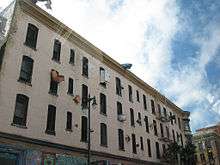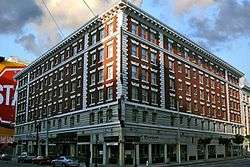Single room occupancy

Single room occupancy (more commonly abbreviated to SRO) is a form of housing aimed at residents with low or minimal incomes in which, typically, single rooms without amenities such as kitchens, toilets or bathrooms, are rented out as permanent residence to individuals, within a multi-tenant building with shared kitchens, toilets or bathrooms.
SROs may constitute a form of affordable housing, in some cases for formerly or otherwise homeless individuals.[1] The term is primarily used in Canada and US.
The term refers to the fact that the tenant rents a single room, as opposed to a flat.
History

The term originated in New York City, probably in the 1930s (the Oxford English Dictionary provides an earliest citation of 1941), but the institutions date back at least fifty years before the nickname was applied to them. SROs exist in many American cities, and are most common in larger cities. In many cases, the buildings themselves were formerly hotels in or near a city's central business district. Many of these buildings were built in the late 19th and early 20th centuries.
The United States saw a decrease in single room occupancy housing during the period of 1960s and 1970s urban decay. For example, in Chicago 81% of the SRO housing stock disappeared between 1960 and 1980.[2]
Many SRO buildings face strong development pressure for conversion to more profitable uses. Some cities have regulated the conversion of SROs to other uses in order to prevent landlords from forcibly evicting SRO tenants, while conversely many others conversely limit the conversion of other uses into SROs and restrict them via zoning. Some cities do both simultaneously, protecting existing new SROs while making it virtually impossible to create new ones. San Francisco passed an SRO Hotel Conversion Ordinance in 1980, which restricts the conversion of SRO hotels to tourist use. SROs are prominent in the Tenderloin, Mission District and Chinatown communities.
In San Francisco, the city may take over particularly squalid SROs, and renovate them for the disadvantaged. Landlords who intend to convert SROs may try to convince their tenants to sign releases, which may require relocation by the landlord and/or compensating the tenant.
The United States Department of Housing and Urban Development subsidizes SRO rehabilitation to combat homelessness, under the McKinney–Vento Homeless Assistance Act of 1987.[3]
In 2001, San Francisco Supervisor Chris Daly sponsored legislation making it illegal for SRO landlords to charge "visitor fees"—a practice long run in order for hotel managers to get a "cut" on drug-dealing or prostitution activities in the building. After a rash of fires destroyed many SROs in San Francisco and left nearly one thousand tenants homeless, a new program to reduce fire risk in SRO hotels was initiated.[4]
Uses
SROs are a viable housing option for students, single tenants, seasonal or other traveling workers, empty nester widows/widowers, or others who do not want or need large dwellings or private domestic appliances. The smaller size and limited amenities in SROs generally make them a more affordable housing option, especially in gentrifying neighborhoods or urban areas with high land values.
The rents of many poor tenants may be paid in full or in part by charitable, state, or federal programs, giving incentive to landlords to accept such tenants. Some SRO buildings are renovated with the benefit of a tax abatement, with the condition that the rooms be rented to tenants with low incomes, and sometimes specific low-income groups, such as homeless people, people with mental illness, people with HIV/AIDS, and so on.
Conditions
Depending on the sensibilities of the landlords and the quality of the properties, SRO conditions can range from squalor to something like an extended-stay hotel. Some have been run in dormitory fashion. Others have been "cage" hotels, in which a large room is split into many smaller ones with corrugated steel or sheetrock dividers, which do not reach the height of the original ceiling. To prevent tenants from climbing over the walls into each other's spaces, the tops of the rooms are covered in chicken wire, making the rooms look something like cages.[5]
See also
References
- ↑ Single-room occupancy hotels disappearing across Chicago - Chicago Tribune
- ↑ The Long, Slow Decline of Chicago's SROs | Chicago magazine | June 2013
- ↑ Single Room Occupancy Program (SRO)/U.S. Department of Housing and Urban Development (HUD)
- ↑ "Sfgov.org | San Francisco Fire Department: Single Room Occupancy (SRO) Hotel Fire Safety". Web.archive.org. 2009-01-17. Archived from the original on January 17, 2009. Retrieved 2013-02-04.
- ↑ "Single Room Occupancy Hotels". Encyclopedia.chicagohistory.org. Retrieved 2013-02-04.
Further reading
- It All Begins with a Home...Transformations Through Housing 2015. by SRO Housing Corporation / Julia Robinson Shimizu. ISBN 978-1497536012.
- Down And Out: The Life And Death Of Minneapolis's Skid Row by Joseph Hart And Edwin C. Hirschoff
- Living Downtown: The History of Residential Hotels in the United States by Paul Groth
- Merrifield, Andy. Dialectical Urbanism: Social Struggles in the Capitalist City. New York: Monthly Review Press, 2002. ISBN 1-58367-060-2. Chapter Six describes SROs in New York City.
External links
- SRO Housing Corporation—a non-profit in Los Angeles that is the largest developer of single room occupancy housing in the Western United States
- Single Room Occupancy Hotels in Chicago
- Central City SRO Collaborative - A non-profit in San Francisco that organizes and assists SRO tenants.
- Single Room Occupancy Program (SRO) - (U.S. Department of Housing and Urban Development)
- Housing Homeless Individuals Through HUD’s Section 8 Moderate Rehabilitation Single Room Occupancy (SRO) Program - A guide to the HUD moderate rehab SRO program, specifically for homeless individuals, includes lessons learned about SROs and additional information.